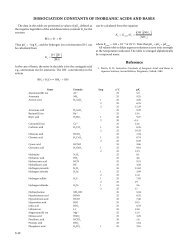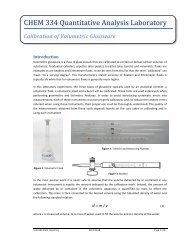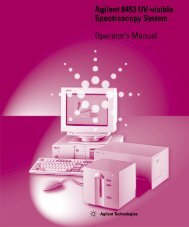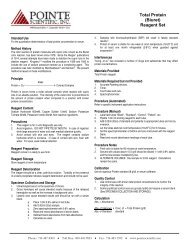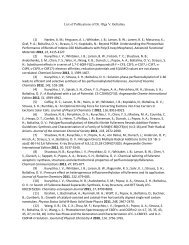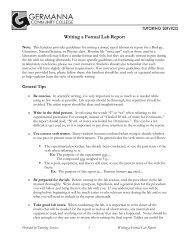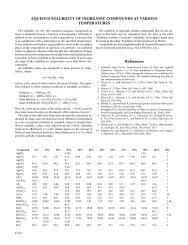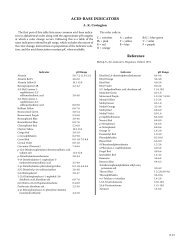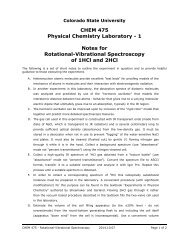Analysis of Protein−RNA Complexes Involving a RNA Recognition ...
Analysis of Protein−RNA Complexes Involving a RNA Recognition ...
Analysis of Protein−RNA Complexes Involving a RNA Recognition ...
You also want an ePaper? Increase the reach of your titles
YUMPU automatically turns print PDFs into web optimized ePapers that Google loves.
Rapid Reportpubs.acs.org/biochemistry<strong>Analysis</strong> <strong>of</strong> <strong>Protein−<strong>RNA</strong></strong> <strong>Complexes</strong> <strong>Involving</strong> a <strong>RNA</strong> <strong>Recognition</strong>Motif Engineered To Bind Hairpins with Seven- and Eight-NucleotideLoopsBrett D. Blakeley, † Jenifer Shattuck, ‡ Melissa B. Coates, ‡ Evelyn Tran, § Ite A. Laird-Offringa, §and Brian R. McNaughton* ,†,‡† Department <strong>of</strong> Chemistry and ‡ Department <strong>of</strong> Biochemistry and Molecular Biology, Colorado State University, Fort Collins,Colorado 80523, United States§ Norris Comprehensive Cancer Center, University <strong>of</strong> Southern California, Los Angeles, California 90089, United States*S Supporting InformationABSTRACT: U1A binds U1hpII, a hairpin <strong>RNA</strong> with a10-nucleotide loop. A U1A mutant (ΔK50ΔM51) bindsU1hpII-derived hairpins with shorter loops, making it aninteresting scaffold for engineering or evolving proteinsthat bind similarly sized disease-related hairpin <strong>RNA</strong>s.However, a more detailed understanding <strong>of</strong> complexesinvolving ΔK50ΔM51 is likely a prerequisite to generatingsuch proteins. Toward this end, we measured mutationaleffects for complexes involving U1A ΔK50ΔM51 andU1hpII-derived hairpin <strong>RNA</strong>s with seven- or eightnucleotideloops and identified contacts that are criticalto the stabilization <strong>of</strong> these complexes. Our data providevaluable insight into sequence-selective recognition <strong>of</strong>seven- or eight-nucleotide loop hairpins by an engineered<strong>RNA</strong> binding protein.Amultitude <strong>of</strong> diverse <strong>RNA</strong> hairpins have been implicatedin human disease. 1−3 These structurally and electronicallycomplex targets can frustrate sequence-selective molecularrecognition strategies centered on small molecules. 4 In contrast,Nature has evolved a suite <strong>of</strong> protein <strong>RNA</strong> recognition motifs(RRMs), capable <strong>of</strong> potent and sequence-specific binding to<strong>RNA</strong> targets. 5−7 These structural motifs are potentiallypromising starting points for engineered or evolved RRMswith enhanced affinity for disease-related <strong>RNA</strong>s, which mayconstitute a unique new class <strong>of</strong> protein therapeutics and basicresearch tools. A prototypical example <strong>of</strong> an RRM is found inthe U1 small nuclear ribonucleoprotein [U1A (Figure 1A)],which binds U1 hairpin II <strong>RNA</strong> [U1hpII (Figure 1B)]. 8,9 TheU1A−U1hpII complex has attracted significant attention andfrequently serves as a model for recognition <strong>of</strong> hairpin <strong>RNA</strong> bya protein. 10−14The native U1A−U1hpII <strong>RNA</strong> complex is stabilized by π−πinteractions involving loop nucleotides C5 and A6 and residuesTyr13 and Phe56 (Figure 1C). 8,15−17 In addition, a hydrogenbond network involving residues Asn15, Asn16, and Glu19 andnucleotides U2, G3, and G4 is implicated, at least in part, insequence-selective recognition <strong>of</strong> U1hpII by U1A (Figure 1D). 8Mutational studies have shown that these residues areimportant contributors to the high stability <strong>of</strong> the U1A−U1hpII complex. 16,18−21Figure 1. (A) U1A−U1hpII <strong>RNA</strong> interaction. (B) U1hpII <strong>RNA</strong>hairpin. (C) π−π interactions between Tyr13 and Phe56 and C5 andA6, respectively. (D) Hydrogen bond network involving Asn15,Asn16, and Glu19 and nucleotides U2, U3, and G4. (E) β 2 −β 3 loopresidues Lys50 and Met51 are deleted in the ΔK50ΔM51 mutant usedin this work.While U1hpII contains a large 10-nucleotide loop, a number<strong>of</strong> disease-related <strong>RNA</strong> hairpins contain four- to eightnucleotideloops. However, features <strong>of</strong> the U1A−U1hpIIinteraction suggest that U1A-derived proteins could be madeto bind <strong>RNA</strong> hairpins with smaller loops. For example, U1Adoes not interact with loop nucleotides U9, C10, and C11,suggesting that smaller loops can be accommodated. 8,22Similarly, residues Lys50 and Met51 in the β 2 −β 3 loop <strong>of</strong>U1A that protrudes into the U1hpII <strong>RNA</strong> loop form no specificinteractions with <strong>RNA</strong> (Figure 1E). While deletion <strong>of</strong> U1hpIIloop nucleotides reduces U1A affinity by ∼3000-fold, acompensatory mutation in U1A that removes residues Lys50and Met51 results in a protein that binds either hairpin withsimilar affinity. 23 These findings imply that the β 2 −β 3 loop actsas a “steric ruler” and establishes lower size limits for the <strong>RNA</strong>Received: June 21, 2013Published: June 27, 2013© 2013 American Chemical Society 4745 dx.doi.org/10.1021/bi400801q | Biochemistry 2013, 52, 4745−4747
BiochemistryRapid ReportTable 1. Binding Affinities for U1A ΔK50ΔM51 Mutants and Eight-Nucleotide Loop U1hpII-Derived <strong>RNA</strong>sentry U1A mutant U1hpII mutant K D a (M) ΔG (kcal/mol) c ΔΔG (kcal/mol) d1 ΔK50ΔM51 8 nt loop (4.0 ± 0.4) × 10 −6 −7.35 −2 Tyr13Gln b 8 nt loop (536.9 ± 106.5) × 10 −6 −4.45 2.903 Phe56Ala 8 nt loop (414.9 ± 81.0) × 10 −6 −4.61 2.744 Asn15Ala 8 nt loop (33.9 ± 2.0) × 10 −6 −6.09 1.265 Asn16Ala 8 nt loop (15.7 ± 1.0) × 10 −6 −6.54 0.816 Glu19Ala 8 nt loop (4.7 ± 0.5) × 10 −6 −7.26 0.097 ΔK50ΔM51 G4A; 8 nt loop (11.8 ± 2.5) × 10 −6 −6.71 0.64a The error for the dissociation constant (K D ) is the standard deviation <strong>of</strong> three separate experiments. b All point mutants are derived from U1AΔK50ΔM51. c ΔG is the free energy <strong>of</strong> the protein in complex with U1hpII-derived <strong>RNA</strong> calculated with the equation ΔG = −RT ln K D . d ΔΔG isthe difference in binding free energy between the complexes in entry 1 and indicated mutants there<strong>of</strong>.Table 2. Binding Affinities for U1A ΔK50ΔM51 Mutants and Seven-Nucleotide Loop U1hpII-Derived <strong>RNA</strong>sentry U1A mutant U1hpII mutant K D a (M) ΔG (kcal/mol) c ΔΔG (kcal/mol) d1 ΔK50ΔM51 7 nt loop (14.5 ± 2.9) × 10 −6 −6.59 −2 Tyr13Gln b 7 nt loop negligible binding − −3 Phe56Ala 7 nt loop negligible binding − −4 Asn15Ala 7 nt loop (34.8 ± 2.7) × 10 −6 −6.07 0.525 Asn16Ala 7 nt loop (43.9 ± 2.3) × 10 −6 −5.94 0.656 Glu19Ala 7 nt loop (17.7 ± 3.5) × 10 −6 −6.47 0.127 ΔK50ΔM51 G4A; 7 nt loop (21.2 ± 3.1) × 10 −6 −6.36 0.23a The error for the dissociation constant (K D ) is the standard deviation <strong>of</strong> three separate experiments.All point mutants are derived fromΔK50ΔM51. c ΔG is the free energy <strong>of</strong> the protein in complex with U1hpII-derived <strong>RNA</strong> calculated with the equation ΔG = −RT ln K D . d ΔΔG isthe difference in binding free energy between the complexes in entry 1 and indicated mutants there<strong>of</strong>.loop matching a given protein derivative. Because ΔK50ΔM51is better suited to binding hairpin <strong>RNA</strong> with smaller loops, itrepresents a potentially interesting starting point for generatingU1A-derived proteins with affinity for similarly sized diseaserelated<strong>RNA</strong> hairpins. However, a more detailed understanding<strong>of</strong> protein−<strong>RNA</strong> interactions involving ΔK50ΔM51 andU1hpII-derived <strong>RNA</strong>s with shorter loops is likely a prerequisitefor the generation <strong>of</strong> such proteins.Toward this end, we prepared a focused library <strong>of</strong>ΔK50ΔM51 mutants (Tyr13Gln, Asn15Ala, Asn16Ala,Glu19Ala, and Phe56Ala) and measured their affinity forU1hpII-derived <strong>RNA</strong>s containing seven- or eight-nucleotideloops. By analogy to identical mutational effects on the U1A−U1hpII interaction, our data implicate residues that stabilizecomplexes between ΔK50ΔM51 and U1hpII-derived <strong>RNA</strong>swith shortened loops and provide a basic framework uponwhich ΔK50ΔM51-derived proteins with altered sequenceselectivity can be engineered or evolved.As detemined by fluorescence polarization, ΔK50ΔM51binds the eight-nucleotide loop U1hpII (U1hpII ΔU8ΔC9)with a dissociation constant (K D ) <strong>of</strong> 4.0 ± 0.4 μM (Table 1,entry 1). Tyr13Gln and Phe56Ala mutants bind the eightnucleotideloop U1hpII-derived <strong>RNA</strong> with ∼134- and ∼104-fold lower affinities, respectively, than ΔK50ΔM51 (Table 1,entries 2 and 3, respectively), consistent with the establishedsignificance <strong>of</strong> these residues in stabilizing the wild-typecomplex. 16 The Ans15Ala and Asn16Ala variants bind ∼8.5-and ∼3.9-fold weaker, respectively, again consistent with theimpact <strong>of</strong> these residues in the native complex, where thealanine mutation reduces affinity by ∼10- and ∼6-fold,respectively. 21 Together, these data establish that expectedclose contacts are maintained when the smaller hairpin is beingbound.Interestingly, while a Glu19Ala mutation in U1A significantlyreduces the affinity for U1hpII in the native complex, an4746identical mutation in ΔK50ΔM51 did not appreciably alter theaffinity for the eight-nucleotide loop U1hpII variant. Asdepicted in Figure 1D, U1A residues Asn15 and Glu19 engagein a bidentate hydrogen bond interaction with nucleotide G4.Baranger and co-workers have shown that mutating G4 toadenine lowers the U1A affinity by ∼10 5 -fold, presumably inpart because <strong>of</strong> the loss <strong>of</strong> a hydrogen bond between thecarboxylate on Glu19 and the exocyclic amine on G4. 24 Giventhe apparent insignificance <strong>of</strong> Glu19 to the new complex, wewondered if a parallel indifference existed toward the G4nucleotide. Indeed, the G4A ΔK50ΔM51 affinity was changed∼2.9-fold (Table 1, entry 7). These data strongly suggest thatthe Glu19−G4 contact from the parent U1A−U1hpII complexis not important for the new interface.Because deletion <strong>of</strong> two nucleotides from U1hpII diminishedone <strong>of</strong> the known contacts with U1A, we next sought to explorethe impact <strong>of</strong> an additional deletion using U1hpII ΔU8ΔC9-ΔU10. As seen in Table 2 (entry 1), ΔK50ΔM51 binds aseven-nucleotide loop U1hpII-derived <strong>RNA</strong> that lacks all threespacer nucleotides (U1hpII ΔU8ΔC9ΔC10) with good affinity(K D = 14.5 ± 2.9 μM). As with the eight-nucleotide loopU1hpII variant, Tyr13Gln and Phe56Ala mutations drasticallyreduced the affinity for the seven-nucleotide U1hpII variant.These data suggest that Tyr13 and Phe56 are involved inbinding the seven-nucleotide U1hpII variant, potentiallythrough π−π interactions similar to those found in the nativecomplex. Similarly, ΔK50ΔM51 binds this seven-nucleotideloop <strong>RNA</strong> hairpin with ∼2.4- and ∼3-fold lower affinityfollowing Asn15Ala and Asn16Ala mutations, respectively(Table 2, entries 4 and 5, respectively). These data suggest abinding mode that relies on Asn15 and Asn16 for stabilization<strong>of</strong> the protein−<strong>RNA</strong> complex. The stability <strong>of</strong> the complexinvolving the seven-nucleotide loop hairpin is given in Table 2(entry 6). The Glu19Ala mutation (Table 2, entry 6) did notsignificantly lower the stability <strong>of</strong> the complex, and the G4Adx.doi.org/10.1021/bi400801q | Biochemistry 2013, 52, 4745−4747
BiochemistryRapid Reportnucleotide variant (Table 2, entry 7) lowered it by only ∼1.5-fold. Thus, as with the eight-nucleotide complex, but in contrastto the parent one, these data suggest a less prominent role forthe Glu19−G4A interaction.Our findings not only improve our understanding <strong>of</strong>protein−<strong>RNA</strong> recognition by U1A variants but also mayprovide a foundation for evolving U1A ΔK50ΔM51 variantswith altered binding specificity. We have reported the firstsolution phase dissociation constants for complexes involvingΔK50ΔM51, and variants there<strong>of</strong>, and seven- or eightnucleotideloop U1hpII <strong>RNA</strong>s, as well as the first mutationalstudies that provide insight into these protein−<strong>RNA</strong> complexes.We have shown that ΔK50ΔM51 binds both shortenedloopU1hpII variants with low micromolar dissociationconstants; the eight-nucleotide loop hairpin is bound ∼3.6-fold tighter than the seven-nucleotide loop U1hpII variant. Likethe native U1A−U1hpII interaction, residues Tyr13 and Phe53on the solvent-exposed surface <strong>of</strong> the β-sheet are critical forprotein−<strong>RNA</strong> complex stabilization. In addition, consistentwith the native interaction, Asn15 and Asn16 play importantroles in hairpin <strong>RNA</strong> recognition. However, unlike the nativecomplex, which partially relies on Glu19 for sequence-selectiverecognition <strong>of</strong> loop nucleotide G4, Glu19 appears to play amuch less important role in the ΔK50ΔM51 mutant. Takentogether, these data provide valuable insight into the elementsfor recognition <strong>of</strong> seven- and eight-nucleotide loop <strong>RNA</strong>hairpins by an engineered <strong>RNA</strong> recognition motif and may beuseful in developing U1A-derived proteins with affinity for■disease-related hairpin <strong>RNA</strong>s with similarly sized loops.ASSOCIATED CONTENT*S Supporting InformationMaterials, detailed experimental protocols, characterization <strong>of</strong>U1A mutants, fluorescence polarization data, and supplementalfigures. This material is available free <strong>of</strong> charge via the Internetat http://pubs.acs.org.■ AUTHORINFORMATIONCorresponding Author*E-mail: brian.mcnaughton@colostate.edu.FundingFunding was generously provided by Colorado State Universityand the Colorado Center for Drug Discovery.NotesThe authors declare no competing financial interests.■ ACKNOWLEDGMENTSWe thank Pr<strong>of</strong>essors Alan Kennan and Olve Peersen for helpfuldiscussions and Grace Campagnola for assistance with initialfluorescence polarization experiments.■ REFERENCES(1) Cooper, T. A., Wan, L., and Dreyfuss, G. (2009) Cell 136, 777.(2) Osborne, R. J., and Thornton, C. A. (2006) Hum. Mol. Genet. 2,R162.(3) Esteller, M. (2011) Nat. Rev. Genet. 12, 861.(4) Gallego, J., and Varani, G. (2001) Acc. Chem. Res. 34, 836.(5) Maris, C., Dominguez, C., and Allain, F. H. (2005) FEBS J. 272,2118.(6) Clery, A., Blatter, M., and Allain, F. H. (2008) Curr. Opin. Struct.Biol. 18, 290.(7) Varani, G. (1997) Acc. Chem. Res. 30, 189.4747(8) Oubridge, C., Ito, N., Evans, P. R., Teo, C. H., and Nagai, K.(1994) Nature 372, 432.(9) Allain, F. H. T., Howe, P. W. A., Neuhaus, D., and Varani, G.(1997) EMBO J. 16, 5764.(10) Hall, K. B. (1994) Biochemistry 33, 10076.(11) Kranz, J. K., and Hall, K. B. (1999) J. Mol. Biol. 285, 215.(12) Hall, K. B. (1993) Biophys. J. 64, A1.(13) Hall, K. B. (1992) FASEB J. 6, A358.(14) Kormos, B. L., Baranger, A. M., and Beveridge, D. L. (2007)Biophys. J., 230A.(15) Nolan, S. J., Shiels, J. C., Tuite, J. B., Cecere, K. L., and Baranger,A. M. (1999) J. Am. Chem. Soc. 121, 8951.(16) Law, M. J., Chambers, E. J., Katsamba, P. S., Haworth, I. S., andLaird-Offringa, I. A. (2005) Nucleic Acids Res. 33, 2917.(17) Shiels, J. C., Tuite, J. B., Nolan, S. J., and Baranger, A. M. (2002)Nucleic Acids Res. 30, 550.(18) Britchi, A. G., Bolton, P. H., and Baranger, A. M. (2007)Biophys. J., 641A.(19) Blakaj, D. M., McConnell, K. J., Beveridge, D. L., and Baranger,A. M. (2001) J. Am. Chem. Soc. 123, 2548.(20) Jessen, T. H., Oubridge, C., Teo, C. H., Pritchard, C., and Nagai,K. (1991) EMBO J. 10, 3447.(21) Fan, Y. (2009) Exploring Protein-<strong>RNA</strong> Interactions with Site-Directed Mutagenesis and Phage Display. Ph.D. Thesis, University <strong>of</strong>Illinois, Urbana, IL.(22) Williams, D. J., and Hall, K. B. (1996) J. Mol. Biol. 257, 265.(23) Katsamba, P. S., Bayramyan, M., Haworth, I. S., Myszka, D. G.,and Laird-Offringa, I. A. (2002) J. Biol. Chem. 277, 33267.(24) Benitex, Y., and Baranger, A. M. (2007) BMC Biochem. 8, 22.dx.doi.org/10.1021/bi400801q | Biochemistry 2013, 52, 4745−4747




